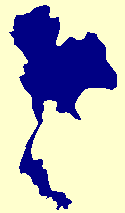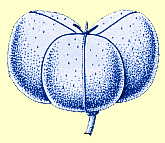
Flora of Thailand
Euphorbiaceae

 |
|
 |
Goto on this page:
Dalzell, Hooker's J. Bot. Kew Gard. Misc. 2: 41. 1850; Pax & K.Hoffm. in Engl., Pflanzenr. IV.147.vi: 98. 1912; Airy Shaw, Kew Bull. 14: 472. 1960; Kew Bull. 26: 210. 1972; Whitmore, Tree Fl. Malaya 2: 52. 1973; G.L.Webster, Ann. Missouri Bot. Gard. 81: 69. 1994; Sevilla & Welzen, Blumea 46: 77. 2001; Radcl.-Sm., Gen. Euphorbiacearum: 132. 2001; Welzen & Sevilla in Chayam. & Welzen, Fl. Thailand 8, 1: 41. 2005; G.L.Webster in Kubitzki, Fam. Gen. Vasc. Pl. 11: 110. 2014. Sarcoclinium Wight, Ic. Pl. Ind. Orient. 5: 24. 1852. Heterocalyx Gagnep., Notul. Syst. 14: 33. 1950.
Shrubs or trees, dioecious or monoecious. Indumentum consisting of simple hairs. Stipules early to late caducous, triangular to narrowly triangular. Leaves alternate, simple, symmetric, papery to coriaceous, base usually attenuate, margin entire to dentate with teeth ending in a gland, apex rounded to cuspidate, both sides smooth, glabrous; nerves pinnate, looped and joined near the margin, veins scalariform. Inflorescences cauliflorous to axillary spike-like thyrses, unbranched, usually several superposed. Flowers actinomorphic, sepals valvate; disc lobed (usually 5 lobes) to annular. Staminate flowers pedicellate, usually several per bract; sepals 2-5; petals (0-)5(-9); stamens 8-16, in a single or in two whorls, inner sometimes united, anthers 2-locular, basally deeply cleft or connective spade-like with anthers in basal lobes; pistillode absent (or present). Pistillate flowers pedicellate, single per bract; sepals (2-)5, petals 5, ovary (2- or) 3-locular, ovules 1 per locule, stigmas often sessile, split in upper part. Fruit a lobed rhegma, smooth. Seeds obovoid, apically carunculate.
Eight species, from South India and Sri Lanka to S.E. Asia and throughout Malesia (Sumatra, Borneo, Philippines, New Guinea); 3 species in Thailand, one of which is a new record. Classification: Subfam. Acalyphoideae, tribe Agrostistachydeae.
|
1a. |
Margin dentate, teeth ending in a gland; veins usually drying somewhat yellowish. Inflorescences up to 3 cm long. |
|
|
1b. |
Margin entire to crenulate, no glands; veins usually drying same colour as blade, brownish. Inflorescences up to 35 cm long. |
|
|
Leaves coriaceous, (sub)sessile. Stipules ovate to triangular, 0.5-4 by 1-8 mm, late caducous. Inflorescences up to 35 cm long, subsericeous to sericeous. Stamens 8-12, in 2 whorls, inner united around pistillode. Seeds 4-6 by 3-5 mm. |
||
|
2b. |
Leaves papery to subcoriaceous; petiole 0.5-4.5 cm long. Stipules narrowly triangular, 2-20 by 2-7 mm, caducous. Inflorescences up to 18 cm long, glabrous to subsericeous. Stamens 10, single whorl, free. Pistillode absent. Seeds 7-9 by 5-8 mm. |
1. Agrostistachys borneensis Becc., Nelle foreste: 331. 1902; Sevilla & Welzen, Blumea 46: 78, Fig. 2, 3e, f, h; Map 1. 2001; Welzen & Sevilla in Chayam. & Welzen, Fl. Thailand 8, 1: 41, fig. 8. 2005. Sarcoclinium longifolia Wight, Ic. Pl. Ind. Orient. 5: 24, pl. 1887. 1852. Agrostistachys longifolia (Wight) Trim., Syst. Cat. Ceylon Pl.: 81. 1885, nom. illeg.; Pax & K.Hoffm. in Engl., Pflanzenr. IV.147.vi: 100, fig. 49e. 1912; Whitmore, Tree Fl. Malaya 2: 53. 1973. Agrostistachys longifolia (Wight) Trimen var. latifolia Hook.f., Fl. Br. India 5: 407. 1887. Agrostistachys latifolia (Hook.f.) Pax & K.Hoffm. in Engl., Pflanzenr. VI.147.vi: 100. 1912. Agrostistachys leptostachya Pax & K.Hoffm. in Engl., Pflanzenr. VI.147.vi: 102. 1912. Agrostistachys coriacea Trim. in Trim. & Hook.f., Fl. Ceyl. 4, Suppl.: 265. 1931, nom. superfl. Agrostistachys longifolia (Wight) Benth. ex Hook.f. var. leptostachya (Pax & K.Hoffm.) Whitmore, Gard. Bull. Singapore 26: 52. 1972.
Shrubs
up to 6 m high. Stipules ovate to triangular, 0.5-4 by 1-8 mm, late caducous,
scars up to 1.5 cm below the leaves. Leaves:
petiole 0(-2) cm long; blade narrowly to linear elliptic or obovate, 6-70 by
2-16 cm, length/width ratio 2-5.5, coriaceous, margin entire, nerves 10-40
per side, drying brownish. Inflorescences
single to up to 4 superposed, up to 35 cm long, subsericeous to sericeous. Bracts
ovate to obovate, 1-4 by 1-4 mm. Flowers
single to 5 per bract. Staminate flowers
2-3 by 1.5-3 mm; pedicel 1-3 mm long; sepals 2-5, 1.5-2.5 by 1-2 mm,
light orangish; petals 5, 1-2.5 by 1-2.5, light orangish; disc lobes 4-6;
stamens 8-12 in two whorls, pale yellow, outer free, inner united with
pistillode, free part of filaments 2-3 mm long; pistillode present. Pistillate
flowers 2-4 by 2-3.5 mm; pedicel 2-5 mm long; sepals 5, 2-3 by 1-2
mm; petals 5, 1-2 by 1.5-2 mm; disc lobes 5; ovary 1-3 by 1.5-4 mm,
stigmas sessile, 1-2.5 mm long. Fruits
6-9 by 5-7 mm. Seeds 4-6 by
3-5 mm.
T h a i l a n d. PENINSULAR: Satun (Nam Ra), Yala (A-machang).
D i s t r i b u t i o n. Sri Lanka, Thailand, Malay Peninsula, Sumatra, Borneo (type), Philippines, Papua New Guinea.
E c o l o g y. Primary and secondary forest, wet evergreen forest, dipterocarp forest, kerangas forest, montane (mossy) forest, swamp forest; in logged over forest, along forest paths and rivers, in open places; common in undergrowth and in open areas; soil: red, brown or yellow sandy clay, limestone, acidic sand. Altitude: 50-2000 m.
V e r n a c u l a r. Mai lao (ไม้เหลา) (Peninsular).
U s e s. Burnt wood produces a black latex which is cosmetically used to dye the teeth black; the dyeing has to be repeated every three days.
2. Agrostistachys gaudichaudii Baill. ex Mόll.Arg., Linnaea 34: 144. 1865; Pax & K.Hoffm. in Engl., Pflanzenr. IV.147.vi: 103. 1912; Airy Shaw, Kew Bull. 26: 210. 1972; Whitmore, Tree Fl. Malaya 2: 52. 1973; Sevilla & Welzen, Blumea 46: 81, Map 2. 2001; Welzen & Sevilla in Chayam. & Welzen, Fl. Thailand 8, 1: 42, plate II: 2. 2005. Sarcoclinium gaudichaudii Baill., Ιtude Euphorb.: 310, 1858, nom. nud. Agrostistachys maingayi Hook.f., Fl. Br. India 5: 406. 1887. Agrostistachys filipendula Hook.f., Fl. Br. India 5: 407. 1887.
Shrubs
or trees up to 15 m high. Stipules
narrowly triangular, 2-20 by 2-7 mm, caducous, scars up to 4.5 cm below the
leaves. Leaves: petiole 0.5-0.7 cm
long; blade elliptic to obovate, 14-55 by 4.5-12 cm, length/width ratio
1.7-5.2, papery to subcoriaceous, margin entire to crenulate, nerves 11-24
per side, drying brownish (to yellowish). Inflorescences
single to up to 15 superposed, up to 18 cm long, glabrous to subsericeous. Bracts
broadly ovate, 2.5-5 by 2.5-6 mm. Flowers
single to 3(-10) per bract, scented. Staminate
flowers 2-3 by 2.5-3.5 mm, white to yellow to greenish; pedicel 2-3 mm
long; sepals 3, c. 2 by 1.3-2 mm; petals 5, 1.3-1.5 by 1.2-1.5 mm; disc
lobes 5, orange to red; stamens 10, in 1 whorl, free, filaments 1.5-3 mm long,
yellow; anthers blue; pistillode absent. Pistillate
flowers 2-3 by 2.5-3.5 mm; pedicel 0.2-1 cm long; sepals 5, 2-3 by
c. 1 mm; petals 5, 1.5-3 by 1.5-3 mm, red-brown; disc annular; ovary 1-2.5
by 1.5-3 mm, stigmas sessile, 1.5-2 mm long. Fruits
5-12 by 8-15 mm, green to grey. Seeds 7-9
by 5-8 mm.
T h a i l a n d. PENINSULAR: Surat Thani (Tha Phet), Krabi (Khao Prabang Kram, Ko Talibong), Trang (Khao Chong, Tale Song Hong), Satun (Kuan Kalong, Terutao), Narathiwat (Waeng).
D i s t r i b u t i o n. Peninsular Thailand and Peninsular Malaysia (type).
E c o l o g y. Primary and secondary forest, evergreen Dipterocarp forest, bamboo forest, swampy forest, logged-over forest, along streams; on undulating country in shade of taller trees or in full sun; soil: limestone. Altitude: sea level up to 400 m.
V e r n a c u l a r. Chik nam (จิกน) (Satun); ta chai (ตาไชย) (Trang); lao (เหลา) (Yala).
3. Agrostistachys indica Dalzell, Hooker's J. Bot. Kew Gard. Misc. 2: 41. 1850; Pax & K.Hoffm. in Engl., Pflanzenr. IV.147.vi: 103, Fig. 20c, d. 1912; Airy Shaw, Kew Bull. 14: 472. 1960; Kew Bull. 26: 210. 1972; Sevilla & Welzen, Blumea 46: 83, Map 4. 2001; Welzen & Sevilla in Chayam. & Welzen, Fl. Thailand 8, 1: 43. 2005. Agrostistachys indica Dalzell subsp. genuina Mόll.Arg. in DC., Prod. 15, 2: 726. 1866, nom. illeg. Agrostistachys indica Dalzell subsp. longifolia Mόll.Arg. in DC., Prod. 15, 2: 726. 1866. Agrostistachys longifolia (Mόll.Arg.) Kurz, Rep. Pegu: App. A cxi, App. B 79. 1875. Agrostistachys maesoana Vidal, Rev. Pl. Vasc. Filip.: 242. 1886. Agrostistachys indica Dalzell var. subintegra Pax & K.Hoffm. in Engl., Pflanzenr. IV.147.vi: 105. 1912, nom. illeg. Agrostistachys indica Dalzell var. maesoana (Vidal) Pax & K.Hoffm. in Engl., Pflanzenr. IV.147.vi: 105. 1912. Heterocalyx laoticus Gagnep., Notul. Syst. 14: 33. 1950.
Shrubs
or trees up to 5 m high. Stipules
narrowly triangular, 4-17 by 2-4 mm, caducous, scars up to 5 cm below the
leaves. Leaves: petiole 0.2-7 cm
long; blade (narrowly) elliptic to obovate, 8-40 by 1.5-13 cm, length/width
ratio 2.2-5.7, papery to subcoriaceous, margin dentate with teeth ending in
glands, nerves 10-27 per side, drying yellowish. Inflorescences
single to up to 6 superposed, up to 3 cm long, subsericeous. Bracts
ovate, 2-6 by 2-5 mm. Flowers
single per bract; sepals 2-5; petals 5(-9). Staminate
flowers 3.5-5 by 3-4 mm; pedicel 4-6 mm long; sepals 3-4 by 2-3.5
mm; petals 2-5 by 1-2.5 mm; disc lobes 5-7(-10); stamens 13-16 in one
whorl, basally united, 2.5-4 mm long; pistillode absent. Pistillate
flowers 5-7 by c. 3 mm, purple; pedicel c. 4 mm long; sepals 3-5 by
1-2 mm; petals 2.5-3.5 by 1-1.5 mm; disc lobes 5(-10); ovary 0.5-1.5
by 1-1.7 mm; style c. 1 mm long; stigmas 1-1.5 mm long. Fruits
12-13 by 8-10 mm. Seeds 5-8 by
5-7 mm.
T h a i l a n d. PENINSULAR: Phangnga (Takua Pa, Thung Maphrao), Nakhon Si Thammarat (Kao Soen), Narathiwat (Waeng).
D i s t r i b u t i o n. India (type), Sri Lanka, Myanmar, Laos, Thailand, Vietnam, Borneo, Philippines, New Guinea.
E c o l o g y. Primary and secondary evergreen forest in undergrowth, along (dry) streams, on low hills and ridges, locally common; soil: clay, sand, rocky and boulder rich. Altitude: sea level up to 400 m.
V e r n a c u l a r. Hang kwang (หางกวาง) (Prachin Buri); plao (เปล้า) (Trang).